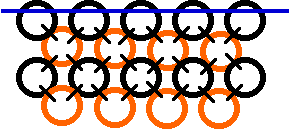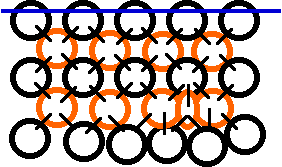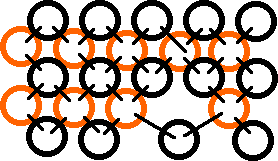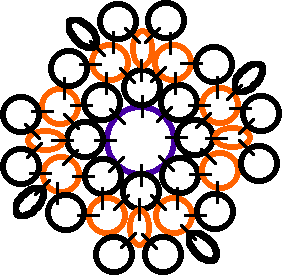'Chain' Mail Production Techniques
as taught by Duke Manfred Kreigstriber, MSCA, OL, Lion of Antir, etc,
etc etc
(mka Mark Chapman, Industrial Engineer)
The primary tenets of this technique are that you
Never
(or at least seldom) have to pass one link through four, you usually
only pass one link through two, and sometimes only through one
Never set your tools down while working, you keep your
pliers in our hands at all times, never setting them down when you pick
up a link at add it to the project.
For a typical application like making a camail or hauberk
you start by sliding several dozen links onto a long straight wire or
cloths-hanger.

You then add
the next row, note the black lines are -not- links,
they represent they represent the overlap between two links

You can then
continue to add rows until you reach some
reasonable sized block of links.. You can then remove this block from
the wire for further work.

You may then
need to increase the length of this chain.
You can do this very similar to adding rows of links. If you are making
a hauberk you will need a chain of links long enough to reach around
the chest (with gambison as needed). If you are makin
g a camail the chain will need to reach around your helmet. Once the
chain is the required length you will need to link the ends together,
here you have to pass one link through four.
If you are
building a camail (or your chest isn't your largest
diameter)
you will need to make the rows longer (wider) reach row. The way to do
this is to adding links. I usually add three links more per row,
building with 15 gauge wire and a 1/4 inch (6mm) ID., But you may need
to change this based on the size of your links. The image below shows
one link added.

You may
also need to decrease the diameter of your project, this
is done by dropping a link, as shown below.

Lastly to
build circular object, like a coif. Start with a single
large
ring (I use a one inch (25mm) dia 10 gauge ring. I then add several
links to this ring. You want enough links so that when you add the next
row these links are not pulled tight, they need to fit loosely. Once
more you will need to increase the diameter of the project with each
row, which means adding links. 





